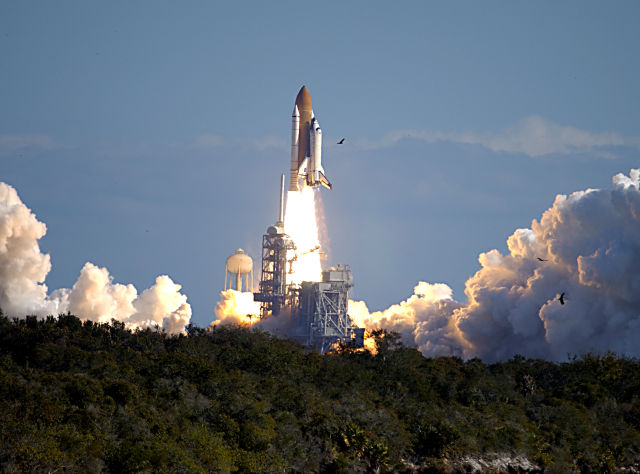
Through a cloud-washed blue sky above Launch Pad 39A, Space Shuttle Columbia hurtles toward space on mission STS-107.
NASA
My first real taste of space journalism came on the morning of February 1, 2003. An editor at the Houston Chronicle telephoned me at home on a Saturday morning and asked me to hurry to Johnson Space Center to help cover the loss of Space Shuttle Columbia.
At the time, I did not realize this tragedy would set the course for the rest of my professional life, that of thinking and writing about spaceflight. This would become the consuming passion of my career.
I've naturally been thinking a lot about Columbia in recent weeks. While the parallels between that Space Shuttle mission and the first crewed flight of Boeing's Starliner spacecraft are not exact, there are similarities. Most significantly, after the Space Shuttle launched, there were questions about the safety of the vehicle's return home due to foam striking the leading edge of the spacecraft's wing.
Two decades later, there are many more questions, both in public and private, about the viability of Starliner's propulsion system after irregularities during the vehicle's flight to the space station in June. NASA officials made the wrong decision during the Columbia accident. So, facing another hugely consequential decision now, is there any reason to believe they'll make the correct call with the lives of Starliner astronauts Butch Wilmore and Suni Williams on the line?
A poor safety culture
To understand Columbia, we need to go back to 1986 and the first Space Shuttle accident involving Challenger. After that catastrophic launch failure, the Rogers Commission investigated and identified the technical cause of the accident while also concluding that it was rooted in a flawed safety culture.
This report prompted sweeping changes in NASA's culture that were designed to allow lower-level engineers the freedom to raise safety concerns about spaceflight vehicles and be heard. And for a time, this worked. However, by the time of Columbia, when the shuttle had flown many dozens of successful missions, NASA's culture had reverted to Challenger-like attitudes.
Because foam strikes had been seen during previous shuttle missions without consequence, observations of foam loss from the external tank during Columbia's launch were not a significant cause of concern. There were a few dissenting voices who said the issue deserved more analysis. However, the chair of the Mission Management Team overseeing the flight, Linda Ham, blocked a request to obtain imagery of the possibly damaged orbiter from US Department of Defense assets in space. The message from the top was clear: The shuttle was fine to come home.
The loss of Columbia resulted in another investigatory commission, known as the Columbia Accident Investigation Board. One of its members was John Logsdon, an eminent space historian at George Washington University. "We observed that there had been changes after Challenger and that they had gone away, and they didn’t persist," Logsdon told me in an interview this weekend. "NASA fell back into the pattern that it had been in before Challenger."
Essentially, then, antibodies within the NASA culture had rebounded to limit dissent.
Advantages for decision makers today
If it does not precisely repeat itself, history certainly echoes. Two decades after Columbia, Starliner is presently docked to the International Space Station. As with foam strikes, issues with reaction control system thrusters are not unique to this flight; they were also observed during the previous test flight in 2022. So once again, engineers at NASA are attempting to decide whether they can be comfortable with a "known" issue and all of its implications for a safe return to Earth.
NASA is the customer for this mission rather than the operator—the space agency is buying transportation services to the International Space Station for its astronauts from Boeing. However, as the customer, NASA still has the final say. Boeing engineers will have input, but the final decisions will be made by NASA engineers such as Steve Stich, Ken Bowersox, and Jim Free. Ultimately, NASA administrator Bill Nelson could have the final say.